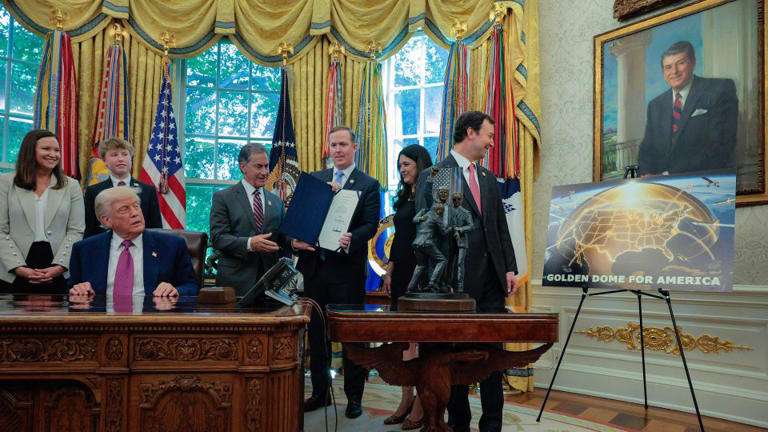In a bold echo of Israel’s Iron Dome, former President Donald Trump has proposed an ambitious missile defence initiative dubbed the “Golden Dome” : a sweeping plan to shield the United States from foreign missile threats using a multi-layered defence system, including for the first time, space-based interceptors.
Positioned as a cornerstone of his national security platform for a potential second term, the Golden Dome project signals a dramatic escalation in American defence posture and may ignite a new phase of strategic rivalry with China and Russia.
A Dome Over America
Unveiled during Trump’s campaign, the Golden Dome envisions a future where the U.S. homeland is protected from hostile missile attacks at every phase of flight — from pre-launch to terminal descent. While traditional systems like Patriot batteries, THAAD, Aegis, and Ground-based Midcourse Defense (GMD) will play supporting roles, the game-changer lies in space-borne interceptors capable of detecting and destroying missiles in orbit.
Trump estimates the program will cost $175 billion, though the Congressional Budget Office has warned the actual price tag could balloon to $542 billion, especially as the space-based component takes shape. The project, according to Trump, will be operational before the end of his next term, should he be re-elected.
A visual representation shown during the announcement depicted a golden-shaded map of the continental U.S., symbolising comprehensive protection, a literal “golden dome” shielding the nation.
 Space: The New Strategic Frontier
Space: The New Strategic Frontier
What sets the Golden Dome apart from prior defense systems is its unprecedented reach into outer space. Experts suggest the project may integrate directed-energy weapons, lasers, and advanced satellite-based interceptors — technologies once confined to science fiction.
General Michael Guetlein, currently Vice Chief of Space Operations, has been tapped to lead the initiative, underscoring the Pentagon’s shift toward orbital defence dominance.
But therein lies the controversy. According to U.S. Air Force Secretary Troy Meink, the project remains conceptual for now — with no secured funding and major design questions unresolved. Still, initial budget requests have surfaced, including a proposed $25 billion allocation tied to a broader tax break bill.
A Strategic Response to Hypersonic Threats
The push for the Golden Dome reflects mounting anxiety in Washington over the evolving missile capabilities of America’s rivals. Both China and Russia have invested heavily in hypersonic missile systems — weapons that travel at more than five times the speed of sound and are notoriously difficult to intercept with existing defences.
By placing interceptors in orbit, the U.S. aims to neutralise such threats during their boost and midcourse phases, when they are most vulnerable — a capability that current ground- and sea-based systems largely lack.
Global Fallout: China’s Red Line
China’s reaction was swift and sharply critical. Chinese defense analysts argue that the Golden Dome could violate existing international norms that discourage the militarisation of space.
“The U.S. Golden Dome missile defence shield will be a violation of the international consensus on keeping space free of military conflict and could inevitably trigger a new arms race in outer space,” warned one Chinese military expert quoted in state media.
Indeed, the project raises fundamental questions about the future of space as a shared global commons, particularly as geopolitical tensions sharpen in the Indo-Pacific and Eastern Europe.
Dome or Domino?
Whether the Golden Dome becomes a reality or remains a campaign talking point, its strategic implications are already reverberating globally. At stake is not only the defence of American soil but the future trajectory of space warfare, international treaties, and global arms control.
For allies, it offers reassurance. For adversaries, it’s a red flag. And for the rest of the world, it may mark the beginning of a dangerous new chapter:

